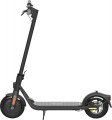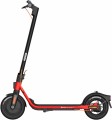Max. load
The maximum weight of the rider that the design of the scooter can withstand without breakdowns and accidents. This moment is partly determined by the age group, and mainly by the materials used in the frame. Note that manufacturers can indicate the maximum load for perfect conditions - when the scooter rides on a perfectly flat surface or even stands still. Therefore, it is worth choosing a model for this parameter with a certain margin. And even more so, you should not exceed the weight indicated in the characteristics - even if the scooter does not break down immediately, this can happen at any time after, which is fraught with accidents and injuries.
Range
The maximum distance that an electric scooter can travel on a single battery charge.
Usually the range is indicated for a flat road and driving only on an electric motor, without the help of a rider. So this indicator is quite conditional, in practice, the distance of the trip may be either less or more, depending on the characteristics of the road and driving style. Nevertheless, according to the claimed range, it is quite possible to estimate the autonomy of different models and compare them with each other.
Note that a
large range (more than 50 km) requires capacious batteries, which affects the dimensions and weight of the device. The real need for such autonomy is not required so often, especially since many electric scooters are quite capable of driving in the usual way, without the use of an electric motor.
Max. climbing angle
The maximum climbing angle that an electric scooter can overcome on engine power alone, without the help of legs. Models with engines of the same power may differ in this indicator (due to the difference in torque and wheel size).
Note that in the specifications the angle is usually indicated in degrees, while on road signs it is given as a percentage (1% corresponds to a rise of 1 m for every 100 m of horizontal movement). However, this moment is not particularly critical: if you often have to overcome a certain hill, you can clarify its slope by converting percentages into degrees (and vice versa) according to special tables. In addition, if the angle turns out to be too large, nothing prevents you from helping the scooter with your foot, in extreme cases, to overcome the climb on foot.
Rear brake
Like a handbrake, the rear brake can be
drum,
electric, or
disc. In addition, there may still be a classic
foot brake, as in ordinary scooters, or not at all.
— Disk. The disc brake on the rear wheel ensures a quick stop of the scooter. These brakes have a short-stroke friction clutch. Due to the small distance between the pads and the disc, the friction clutch very quickly comes into contact with the working surface of the brake disc. In this case, the friction clutch is pressed against the disk with a sufficiently large force. The disc brake allows the scooter to stop extremely efficiently. But when using a disc brake on the rear wheel, you should be careful, because when braking hard, especially when cornering, the scooter can skid to the side.
- Drum. The drum type brake has above average efficiency. The drum brake makes the rear wheel massive and heavy. This type of brake has a closed design. The pads are inside the wheel. Friction linings rub against the inner surface of the rim. Access to the drum brake is closed by a protective cover. Thanks to the closed design, neither moisture nor other blockages get inside the brake drum, which makes the brake operation more reliable and trouble-free. Among the shortcomings can be noted: an increase in the dimensions and weight of the wheel, the complexity of maintenanc
...e.
- Foot. The simplest kind of clamping type brakes, which involves slowing down and stopping the scooter by pressing your foot on the fender of the rear wheel. Note that this is the least efficient braking system of the existing options.
- Electric - braking with the help of recuperation. The brake system of this type makes the stop extremely soft, slowing down occurs when the speed of the electric motor decreases. The rear location of the electric brake assumes that the electric motor is mounted on the rear wheel. The presence of an electric motor makes the wheel massive. The electric type brake system is highly reliable and durable, it does not require maintenance. But if the battery pack on the scooter runs out, the electric brake will not work. For such cases, an additional mechanical (hand or foot) brake is usually provided.
- Absent. The rear wheel is not equipped with a brake. In this case, the braking system is provided at the front. The advantage of scooters without a rear brake is that the vehicle will not skid to the side when braking actively when cornering.Battery capacity
Battery capacity installed in the electric scooter.
Theoretically, a higher battery capacity allows for a longer range, but in fact, not everything is so clear. Firstly, motors of even the same power can differ in efficiency; secondly, the actual amount of energy stored in the battery depends not only on the capacity in amp-hours but also on the voltage in volts. So this parameter is secondary, and when choosing, it is worth focusing not so much on the battery capacity, but on the directly claimed range. You can compare capacity only for models with similar characteristics and the same supply voltage.
Voltage
In general, this parameter is of secondary importance; in fact, it is needed mainly when looking for a spare / replacement battery or a third-party charger. When choosing, it is worth paying attention to characteristics that are closer to practice - in particular, directly claimed speed and power reserve.
Full charge time
Time to fully charge the battery from zero to 100%.
The more powerful the device, the more capacious batteries it needs and, as a rule, the longer the charging time. In the heaviest models, it can reach 20 hours. However, such indicators are rare - most electric scooters are charged for a maximum of 8-9 hours, which allows you to put the device on charge “from evening to morning”.

